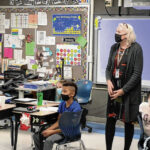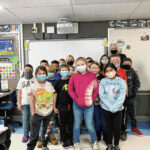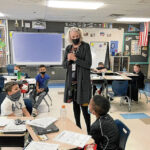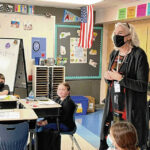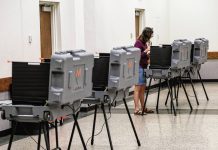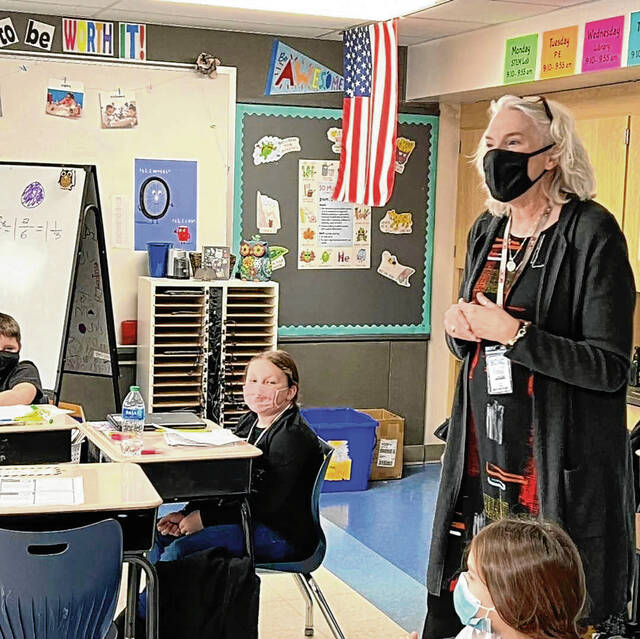
Photo provided Bartholomew Consolidated School Corp. Director of Elementary Education Laura Hack serves as the substitute teacher for a fourth grade class at Smith Elementary School, where she formerly served as principal.
Local school corporations are adjusting for staffing vacancies in the wake of the COVID-19 omicron surge and working to fill the gaps with a number of different solutions.
Bartholomew Consolidated School Corp. Superintendent Jim Roberts said at a recent board meeting that school officials continue to monitor staffing numbers closely, as these affect BCSC’s ability to “keep the buses running, classrooms open, food being provided, buildings clean and ready to go for the next day.”
Each day the school corporation looks at its classroom teacher absences and works to fill these with substitutes. Then they look at the gaps that still remain. At present, about 80 to 90 teachers are out on a typical day — or more than 10% of the district’s 770 certified staff. Then there are a smaller number of classrooms that still need to be staffed after others are filled by subs.
“From a teacher standpoint — if we think about classrooms, for example, all last week we were around 25 unfilled positions as we started the day,” Roberts said. “So with the number of subs that we might need, we still might end up with about 25 that weren’t covered. Our building administrators, teachers’ assistants, other support staff, classroom teachers sacrificing prep time to go and cover a class during that time — whatever that has been, our administrators have become creative and have great staff members to work with.”
If a single school has several of those openings at once, he said, this may entail allocating human resources from throughout the district to help that building. For instance, the school corporation shared on social media that Director of Elementary Education Laura Hack recently helped out as a substitute teacher in a fourth grade classroom on Jan. 18.
The school corporation is filling more substitute positions than it ever has and spent over $1.2 million on substitute teachers in 2021 — compared to a prior peak of about $700,000 in 2018, Roberts said. However, despite the number of substitutes BCSC employs, there are still a large number of openings that still need to be filled. And, in some cases, former substitutes have decided not to return due to the pandemic.
The school’s transportation department has also had to get creative about absences. Roberts said that in some cases, a bus driver may run one route and double back to do another, or add stops to their normal route if they have the space to seat additional kids. Transportation office staff have also been substituting on routes for a while.
“Interestingly enough, while Jennings County was doing eLearning, we are thankful that the licensed drivers for their buses were offered by their district to help BCSC,” Roberts said. “So Jennings County Schools basically helped communicate to their drivers that we had some vacancies and they were okay with those drivers coming over to us and filling in on those days that they weren’t having school.”
There have also been shortages in the custodial department, though Roberts said that the staff have been flexible about reassignments and changes. The school corporation also recently started an initiative to fill absences by recruiting eligible students to work as evening custodians. Six have applied, and a few have already been hired.
In general, Roberts told school board members that the ratio of student to staff cases has decreased over time, with positive cases among staff members becoming more common. He also reminded officials that when the school corporation temporarily moved to eLearning in November of 2020, it was more due to “operational abilities” than the number of students out sick.
At that time, the superintendent said that positive cases and close contacts were causing issues for transportation and staffing. On Nov. 5, 2020, the school corporation was 23 bus drivers short of covering its routes and 21 classrooms “without the proper staff,” even after allocating internal resources. On Nov. 26, 2020, there were 29 classrooms without an available teacher.
However, different COVID-19 protocols have been adopted by the school corporation since that time, such as the recent shift to five-day quarantines and changes to quarantine requirements for asymptomatic close contacts in masked environments.
Additionally, Roberts told board members the Indiana Department of Health recently gave schools new guidance in regards to contact tracing, and BCSC officials are still analyzing the information.
Schools with a mask requirement are no longer required to report close contacts to the state K-12 portal and “the number of fields they need to report has been reduced,” according to state health officials.
“Schools that meet these criteria should still send blanket notifications to families when a positive case is identified in a classroom and may continue to conduct contact tracing as they have been if they so choose,” the department official said. “Schools that do not have mask requirements in place must continue notifying close contacts and reporting all required fields to the state portal.”
“What we’re trying to discern is, if we don’t have to report close contacts to the state — or at least are not having to report them to the degree that schools are that don’t have a mask requirement — does that mean that those students don’t have to quarantine either?” said Roberts. “Because we are still, regardless of that reporting requirement, going to know who close contacts are, because we need to know and at least inform parents. … But with that, is the health department saying that there’s no quarantine requirement either? And that’s the way that we’re interpreting it. We’ve not implemented that yet.”
If this is the case, he said, it would be another reason to continue masking. However, it also raises questions about what to do regarding individuals identified as close contacts outside of school and whether or not BCSC should require them to quarantine.
In regards to the possibility of future eLearning, Roberts told officials that reasons to make that move might include continued spread or operational circumstances. However, the school corporation’s goal is to keep students in school “to the best of our ability.”
When asked by school board member Nicole Wheeldon if officials might consider “different outcomes for different schools” based on operational capacity, he said that this is “always a possibility,” though they would hope to avoid closure.
“Sometimes I’m asked about setting a number — ‘If we get to this number, then we were going to go to eLearning’,” Roberts said. “The problem with setting that number is then we stop trying to solve the problem when we get to that or close to that number. And I don’t even know what number would be operationally in terms of saying ‘this percent, this number of people in this building.’”
He added that while they may reach a point that causes a change, they would prefer to do that by building or grade level rather than shut down the entire district.
Flat Rock-Hawcreek
Flat Rock-Hawcreek School Corp. Superintendent Shawn Price said COVID-19 is creating “unique challenges” in that district as well.
“The last two weeks, we’ve seen an uptick in our numbers within our staff, specifically in the areas of transportation,” he said. “And we’re already pretty thin when it comes to our certified bus drivers, and then we’ve kind of had to move some routes around and do some things to get creative there.”
Staffing has been an issue at Hope Elementary in particular, with a number of both certified and noncertified staff out on the week of Jan. 17, though shortened quarantine times have helped individuals come back “in a timely fashion.”
“This year, we’ve been fortunate to have a larger sub pool than we’ve had in the previous two years,” said Price. “So we’ve been able to lean heavily on that. Another nice thing about being one campus with both the schools combined, we’re able to share staff when we have common periods. We also have a lot of staff members that have been willing to step in during their prep time to cover classes.”
If the school corporation was in a position where there wasn’t coverage or available substitutes, they would consider a move to eLearning, he said. It would be “very situational” and depend on where absences occur. Price noted that one of the school corporation’s more vulnerable areas is transportation, as they don’t have a lot of subs for drivers.
In terms of COVID-19 protocols, Price said that Flat Rock-Hawcreek has moved to five-day quarantines and remains mask-optional in most situations. However, masks are required on school buses and as part of enhanced precautions for individuals returning from quarantine, whether due to testing positive or being a close contact.
“When we went to virtual learning back in November of ‘20, I think that that really was pushed by staffing shortages, and having staff out for 10-14 days or more made it very difficult to get people back and covering the building,” said Price.
At present, shorter timelines, along with milder cases, have allowed the school corporation to keep more staff in the building, he said.
Photo provided Bartholomew Consolidated School Corp. Director of Elementary Education Laura Hack serves as the substitute teacher for a fourth grade class at Smith Elementary School, where she formerly served as principal.
Photo provided Bartholomew Consolidated School Corp. Director of Elementary Education Laura Hack is shown with a fourth grade class where she served as the substitute teacher at Smith Elementary School. Hack was formerly principa at Smith.
Photo provided Bartholomew Consolidated School Corp. Director of Elementary Education Laura Hack serves as the substitute teacher for a fourth grade class at Smith Elementary School, where she formerly served as principal.
Photo provided Bartholomew Consolidated School Corp. Director of Elementary Education Laura Hack serves as the substitute teacher for a fourth grade class at Smith Elementary School, where she formerly served as principal.

